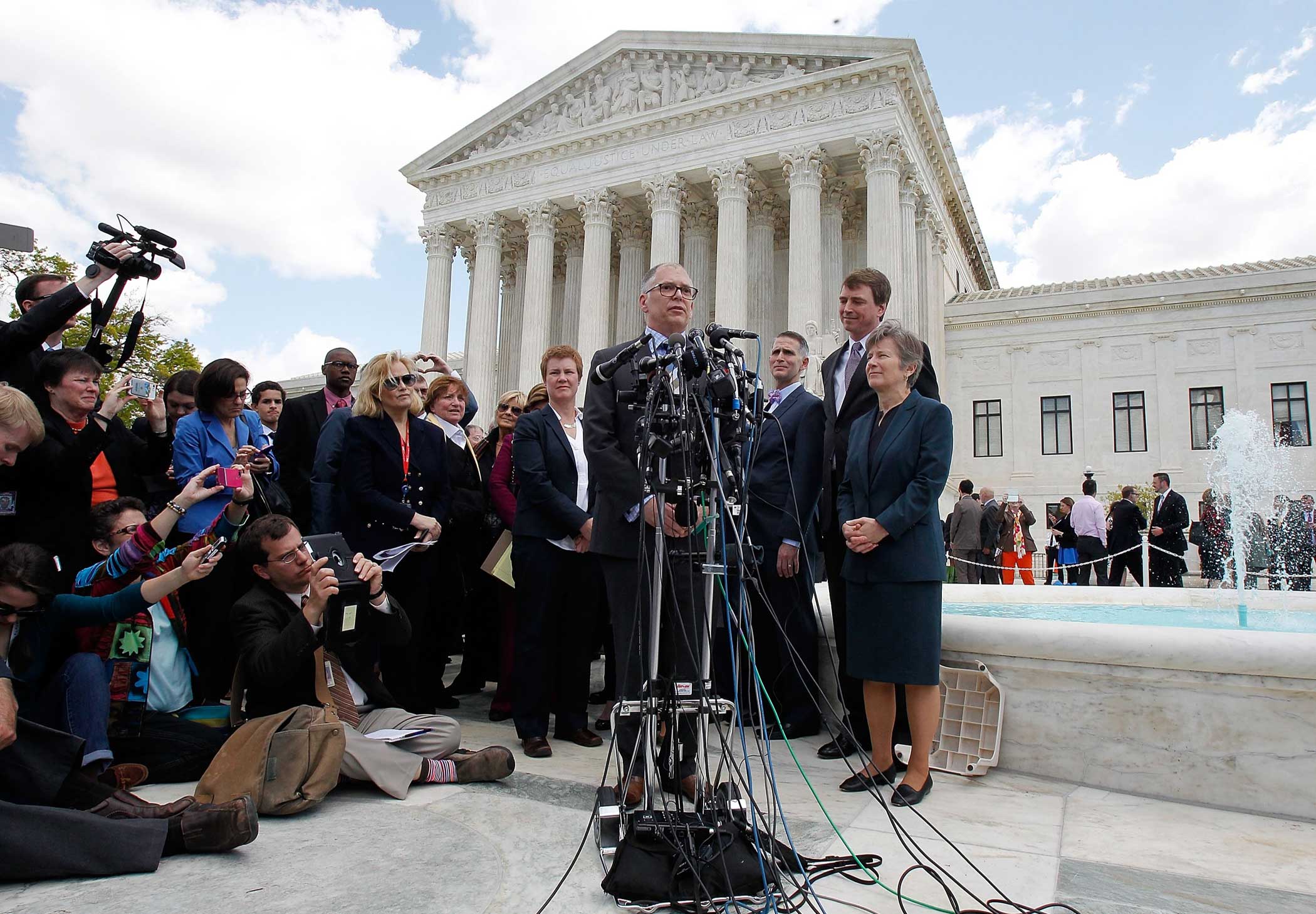
The sun rises behind Jim Obergefell as he stands below the Supreme Court steps early Tuesday, and it frames his head in a perfect halo.
To his surprise, he had managed to sleep — “for 3.5 hours, 3 hours more than I expected,” he says — before waking up at 4:30 a.m. to arrive at the court at 6:15. He recalled how the Capitol across the way, was pink and gray against the early blue sky, as he approached the courthouse. “As it started to get lighter, the white marble of the Supreme Court was just — it was kind of magical,” he says as he waits for the Court doors to open. “It really was.”
He shows me his wedding ring. It is two bands, his ring and his late husband John Arthur’s, fused together, with a channel cut inside to hold some of Arthur’s ashes, sealed in with gold. Arthur died in 2013 of Lou Gehrig’s disease — the same ALS illness that millions fought last summer via “ice-bucket challenges” — and Obergefell, who was raised Catholic, has been fighting ever since to be listed as his spouse on his death certificate. Ohio, where he and his late husband live, neither allows gay marriage nor recognizes marriages, like theirs, performed in other states.
In just a few hours, Obergefell would sit near the front of the country’s highest court, supported by his late husband’s aunt and alongside fellow plaintiffs from Michigan, Tennessee and Kentucky. Together, their cases, argued under Obergefell v. Hodges, asks what is perhaps this generation’s greatest civil rights question: do same-sex couples should have the Constitutional right to marry?
The Justices considered two questions over the two and a half hours the court was in session. First, does the Fourteenth Amendment require a state to license a marriage between two people of the same sex? And second, does the Fourteenth Amendment require a state to recognize a marriage between two people of the same sex when their marriage was performed out-of-state?
None of the lawyer’s arguments on either side were particularly new, and neither were any of the justices’ questions. What made the case compelling was hearing the same old debate play out in the highest court of the land with so much at stake.
Justice Samuel Alito asked why allowing same-sex marriage wouldn’t lead to two men marrying two women. Justice Antonin Scalia wondered if clergy would be required to perform wedding ceremonies for unions to which they object. Chief Justice John Roberts asked if denying gay marriage was sexual discrimination. Justice Ruth Bader Ginsburg argued that the definition of marriage has already changed.
By the time the court emptied into the plaza outside, the warm midday sun had fully risen over hundreds of supporters and protesters awaited, some cheering, some yelling, others just there amid the signs and coffee cups that littered the ground like the end of a long day at the state fair.
Legal scholars will now pore over the transcript and the briefs, examine the merits and point out the flaws. But no matter the decision the Court hands down in two months, Obergefell matters most for the people, like Obergefell himself, that it represents. “Right now is what creates the urgency for the court to decide whether the states are denying people basic equality,” Mary L. Bonauto, the lawyer who argued for the right of same sex marriage at the Court, says.
Perhaps that’s why one moment, minutes before attorney Douglas Hallward-Driemeier finished his closing argument, meant the world to Obergefell himself. “Douglas mentioned my name and John’s name, and our marriage, and why we were there,” he says, his voice catching, ever so slightly. “That was when it all sunk in.”
Ohio may not recognize Obergefell’s marriage yet, but for a brief moment in the Supreme Court Tuesday, attention was paid.
More Must-Reads from TIME
- Why Trump’s Message Worked on Latino Men
- What Trump’s Win Could Mean for Housing
- The 100 Must-Read Books of 2024
- Sleep Doctors Share the 1 Tip That’s Changed Their Lives
- Column: Let’s Bring Back Romance
- What It’s Like to Have Long COVID As a Kid
- FX’s Say Nothing Is the Must-Watch Political Thriller of 2024
- Merle Bombardieri Is Helping People Make the Baby Decision
Contact us at letters@time.com